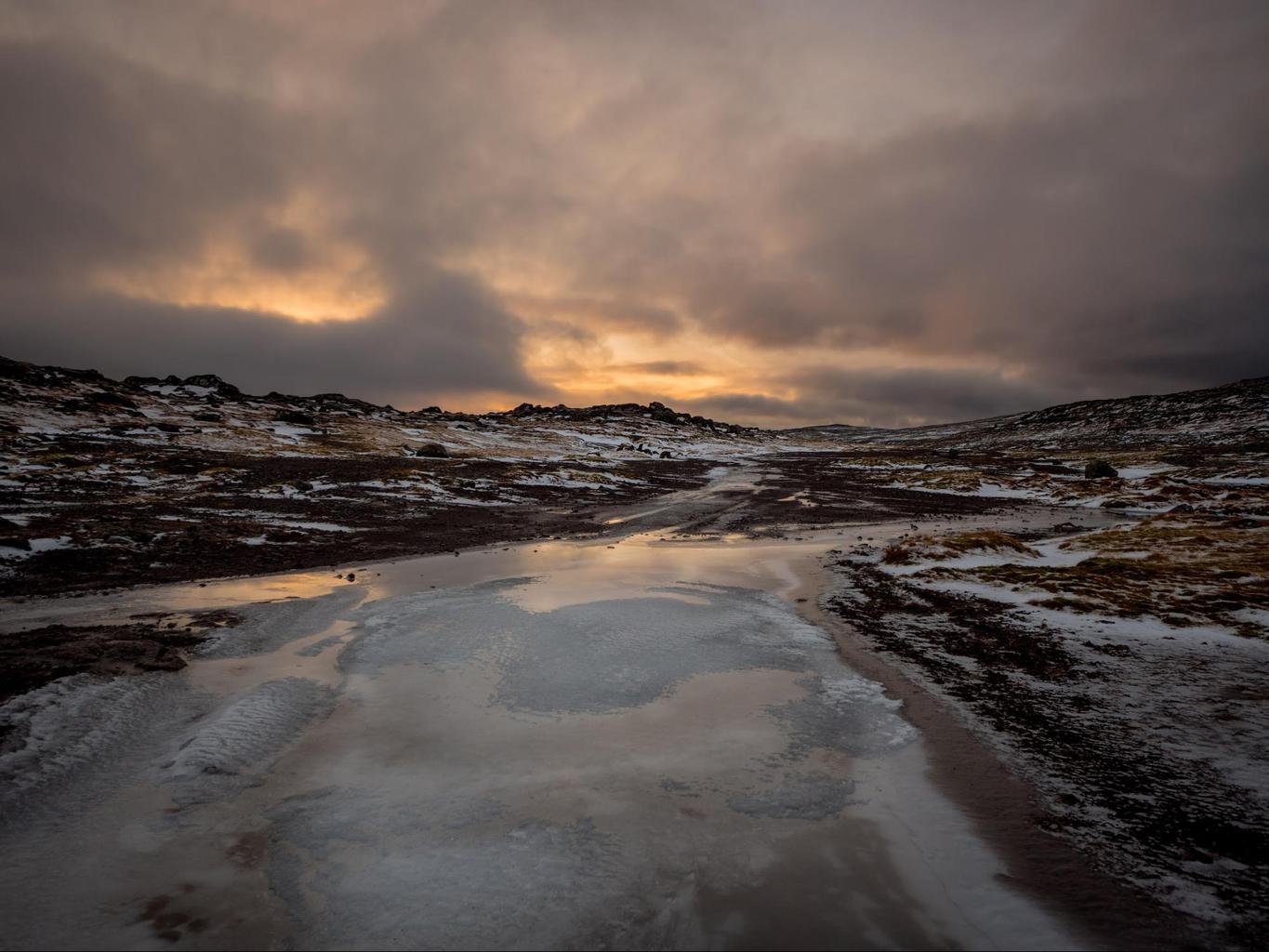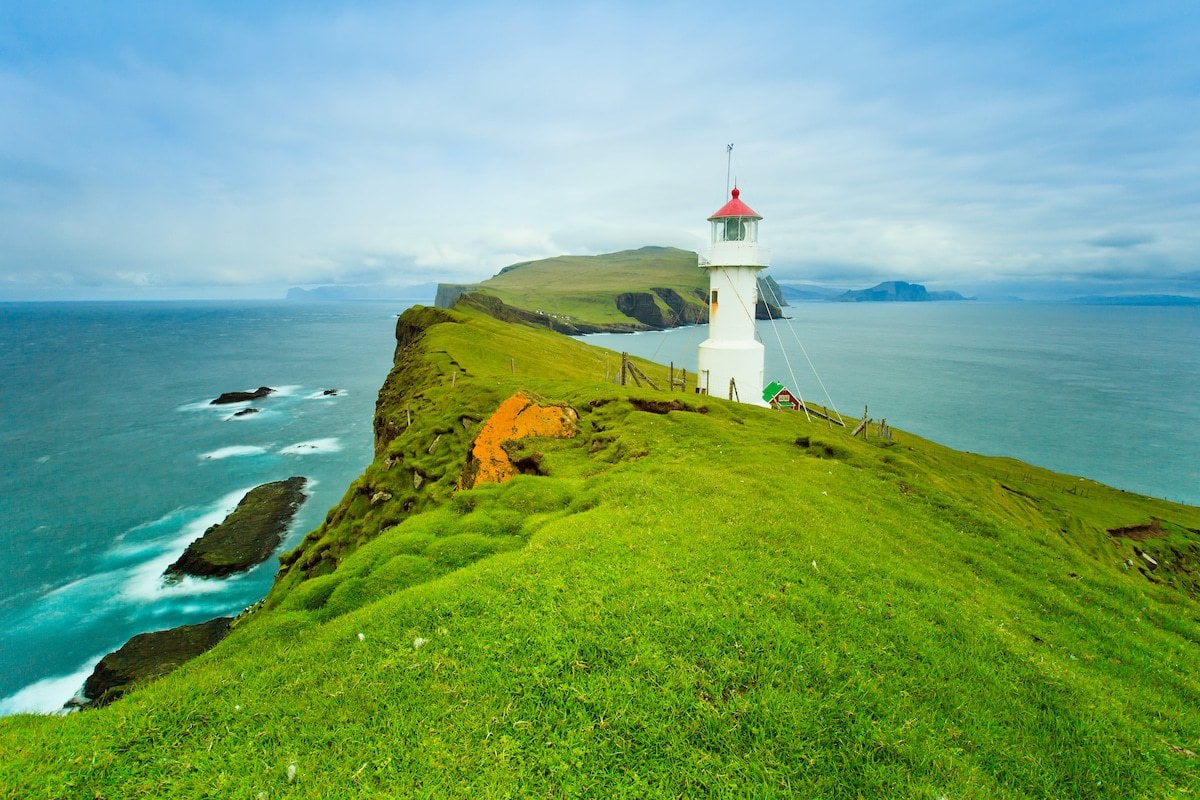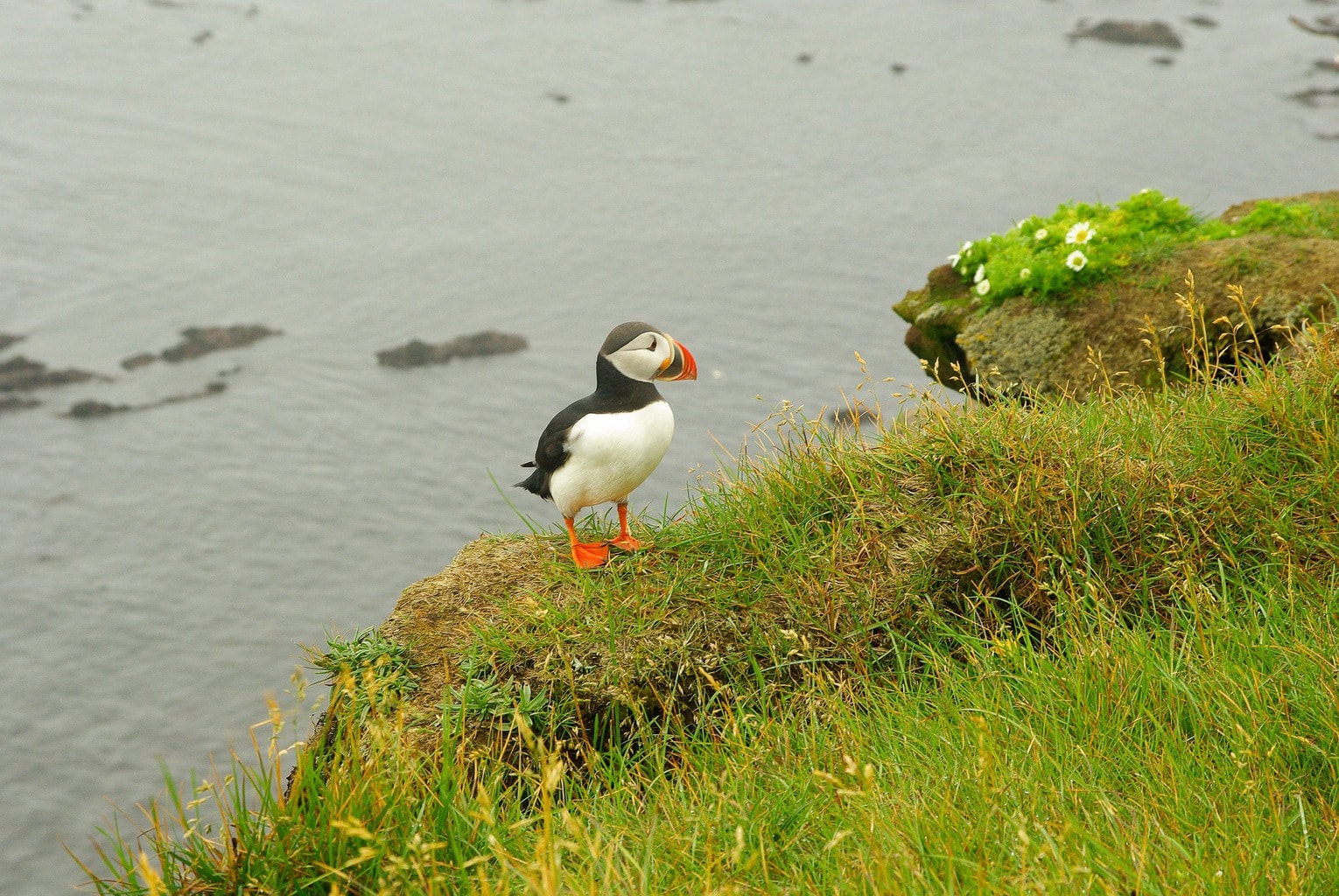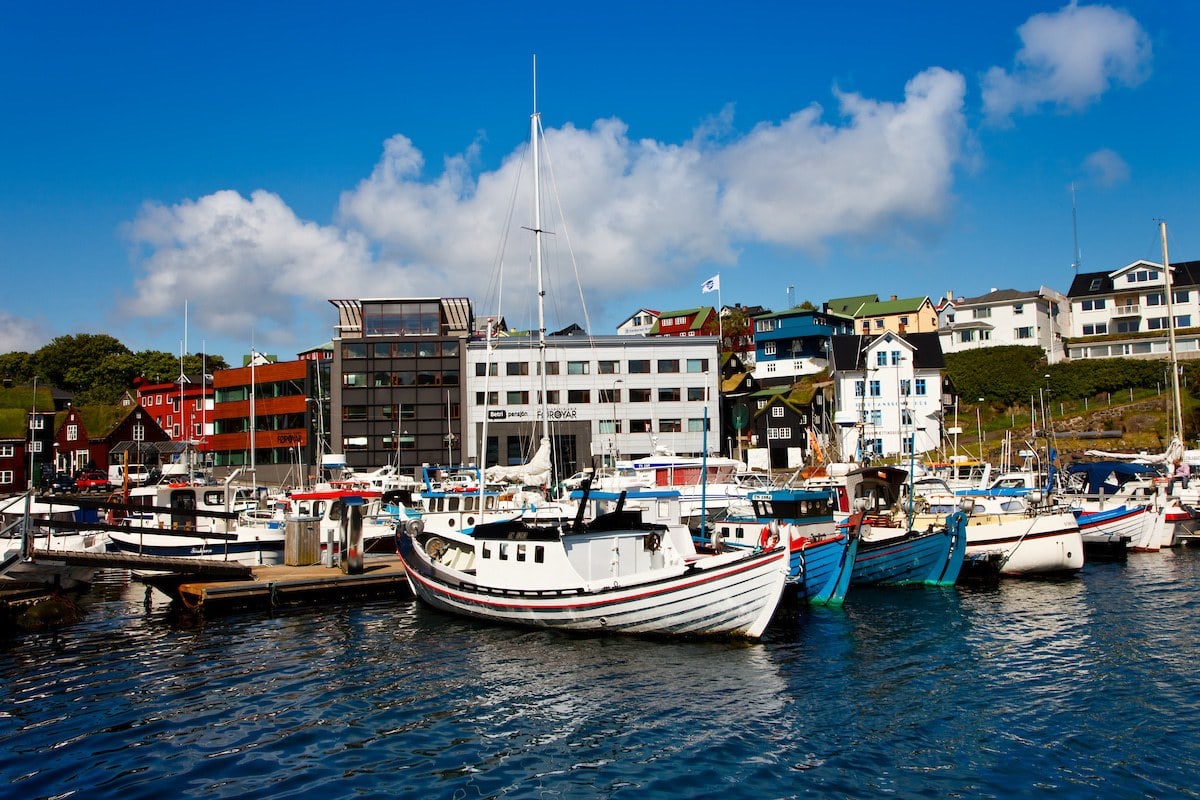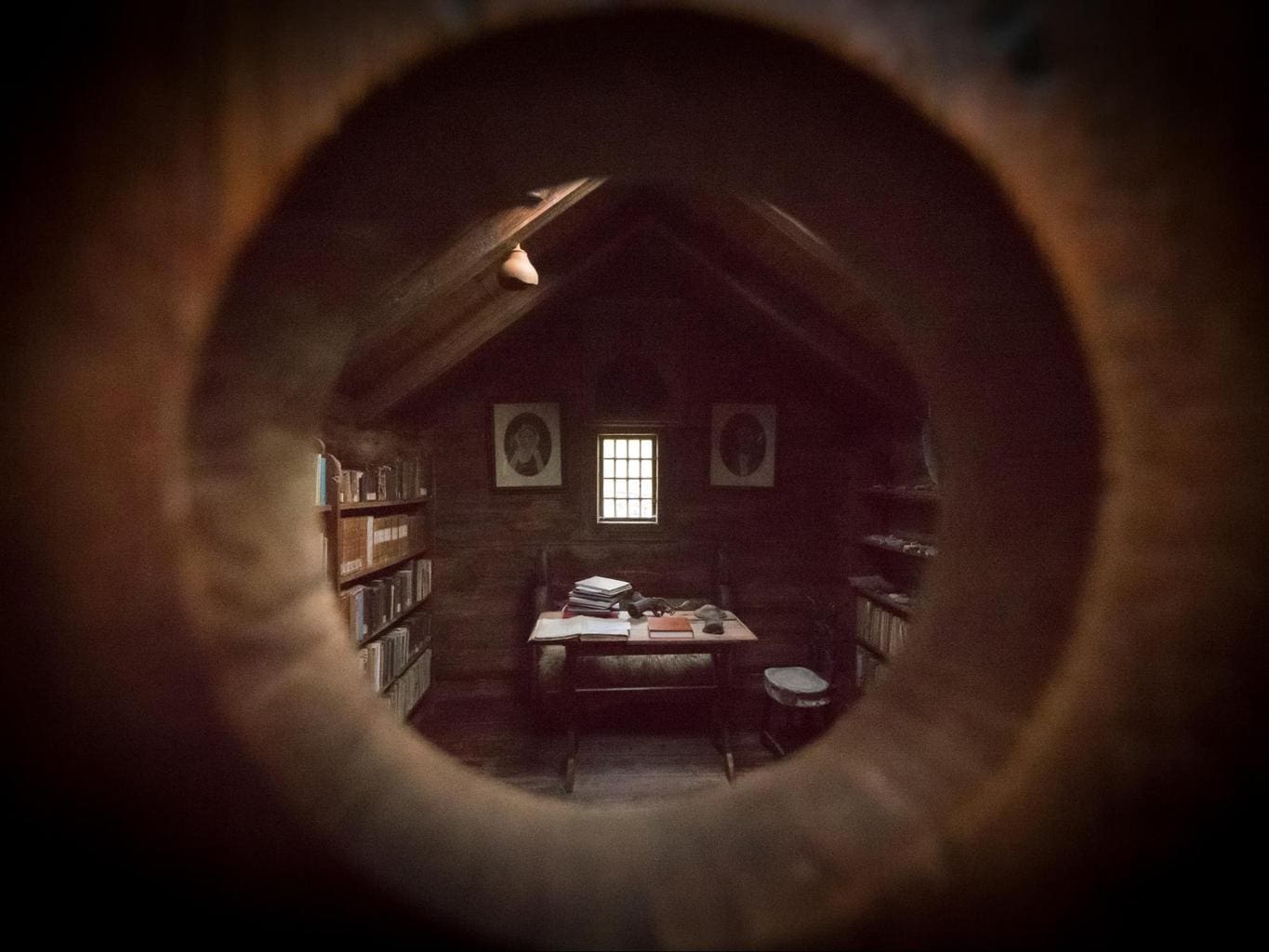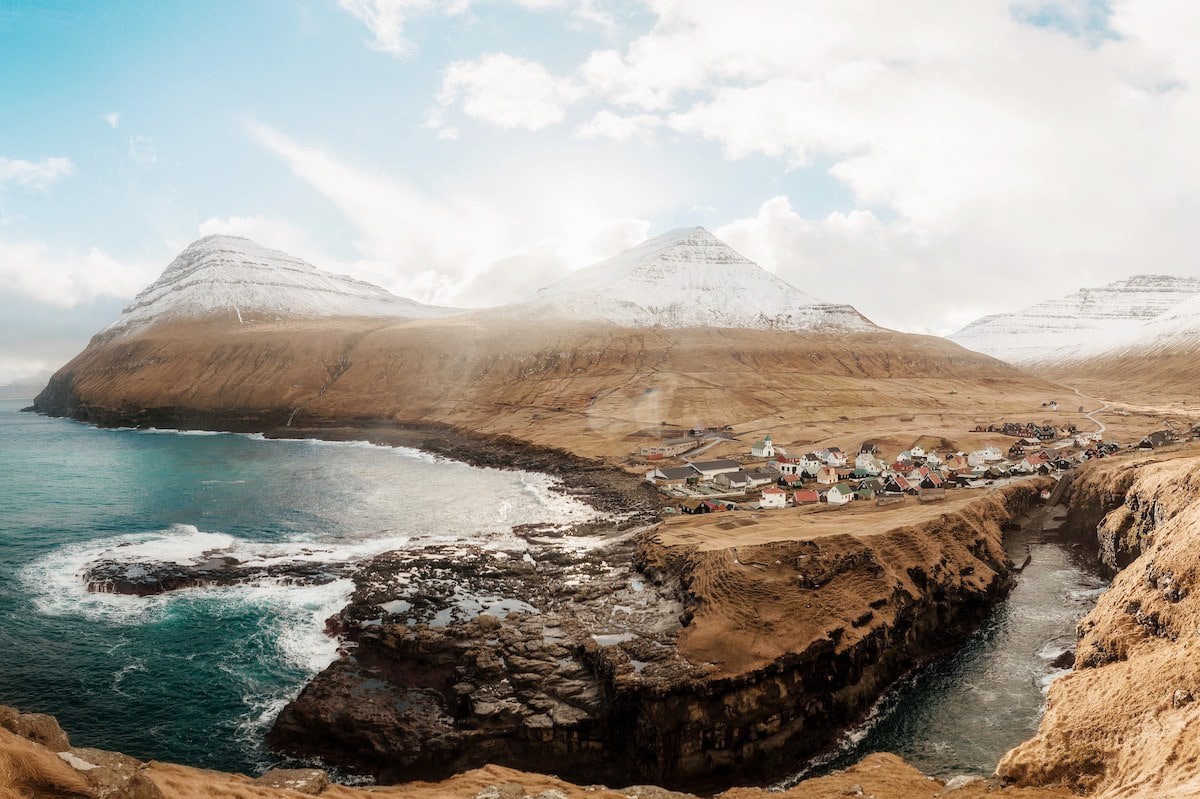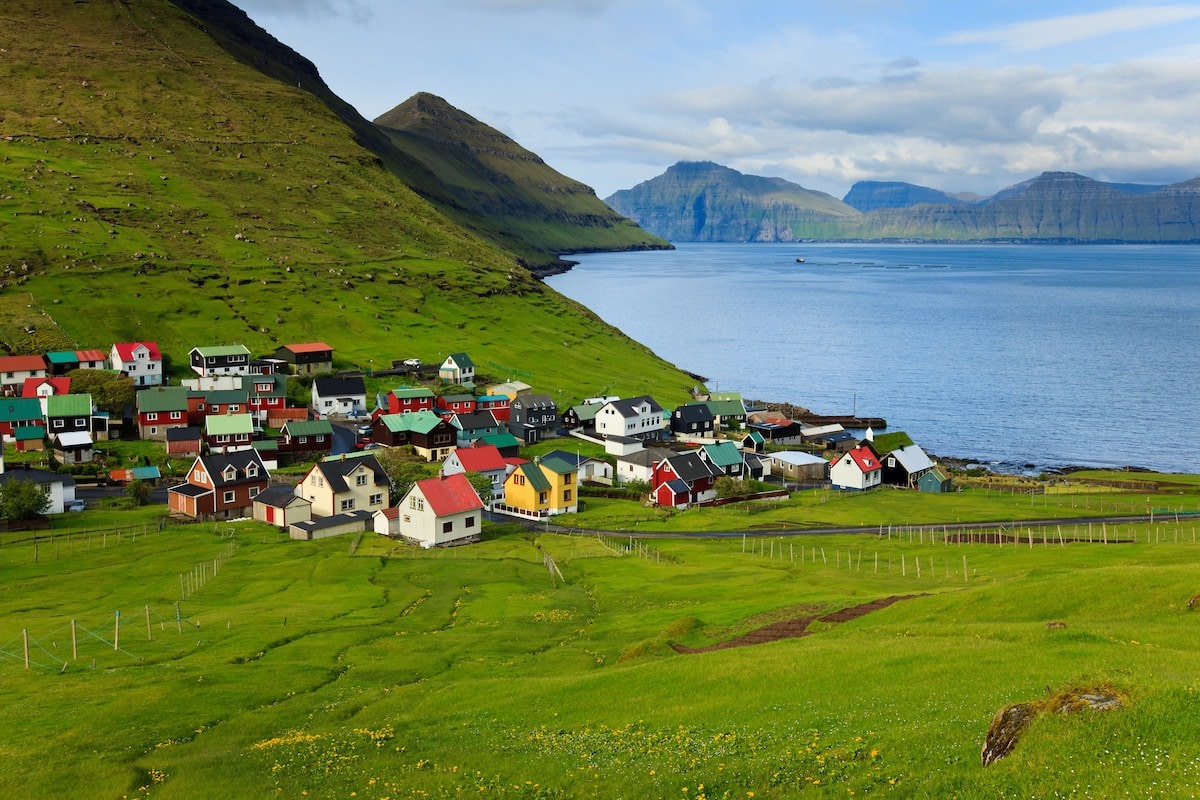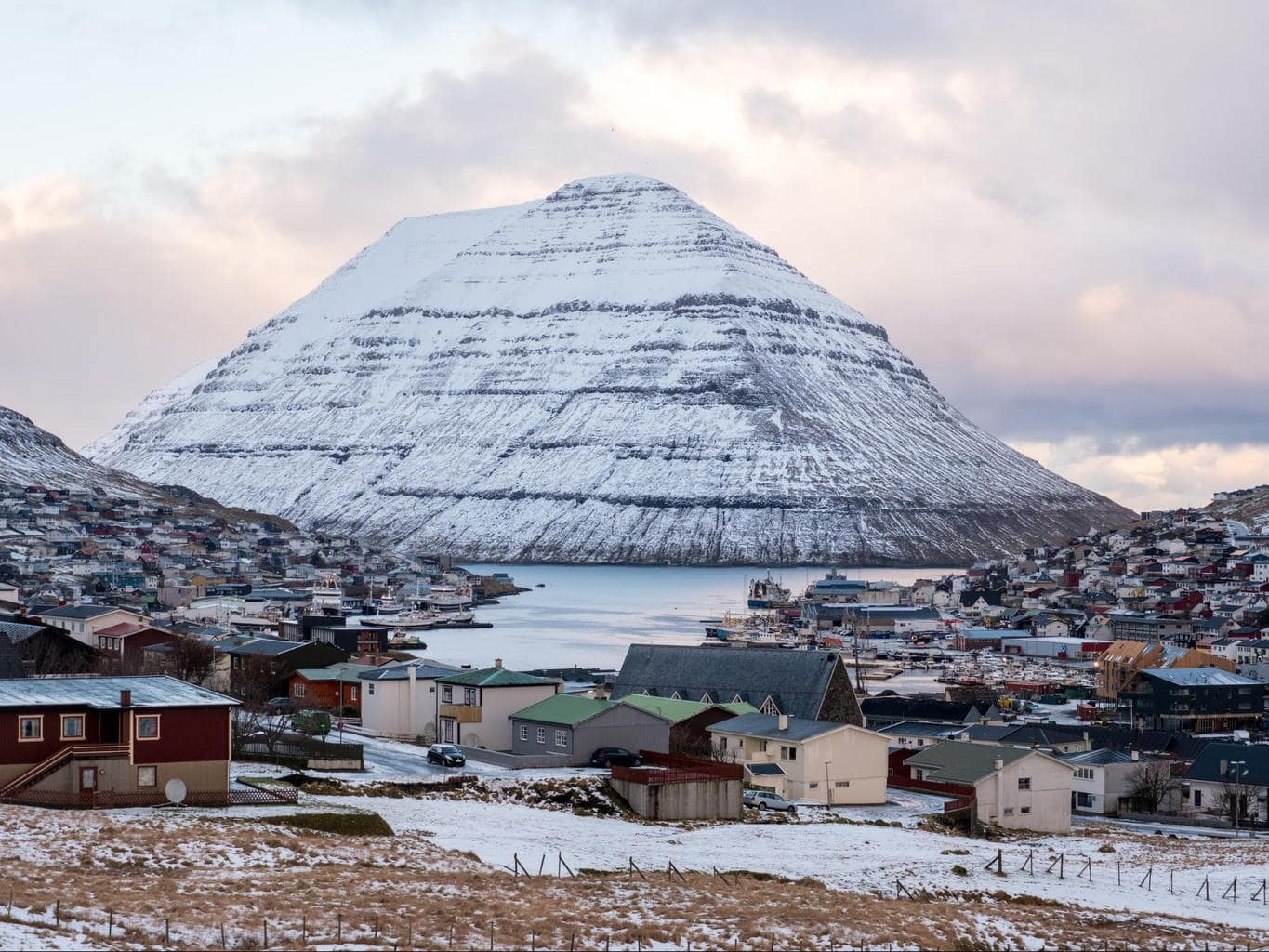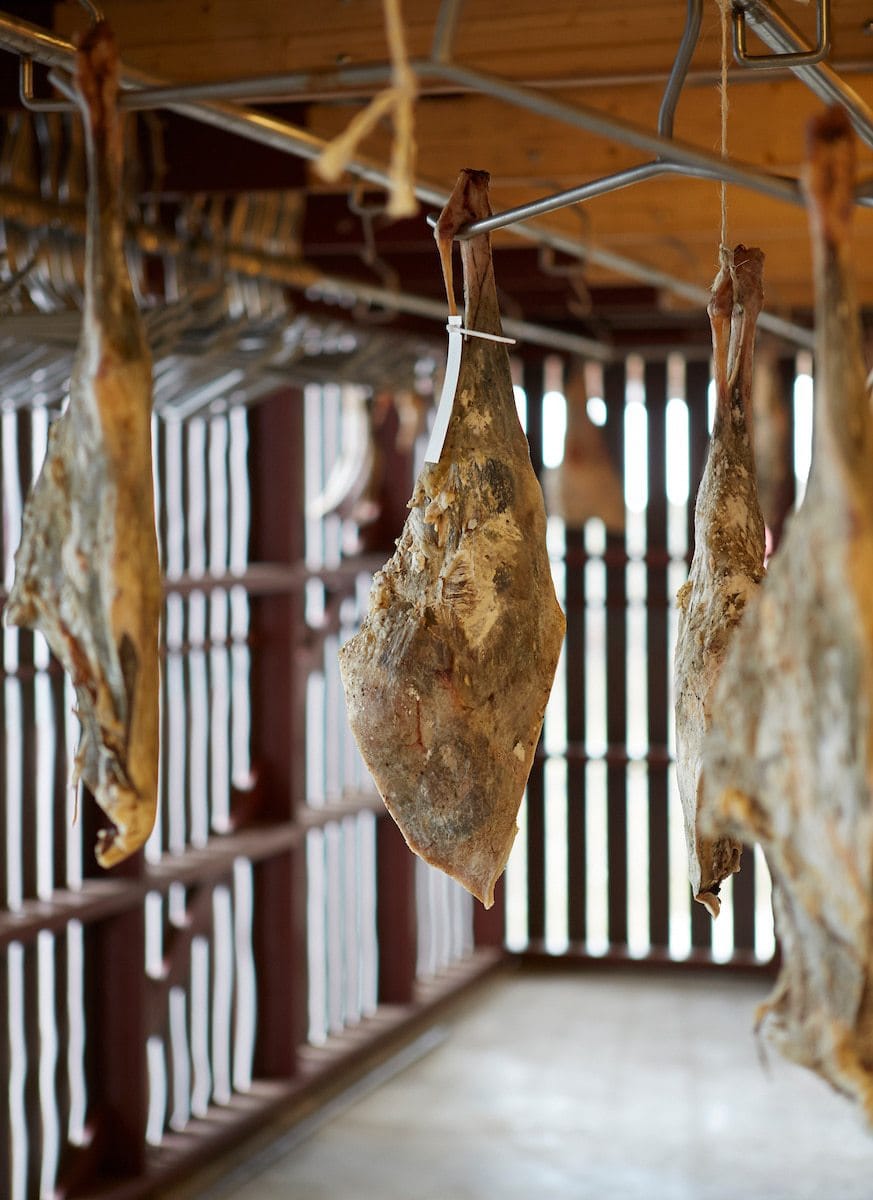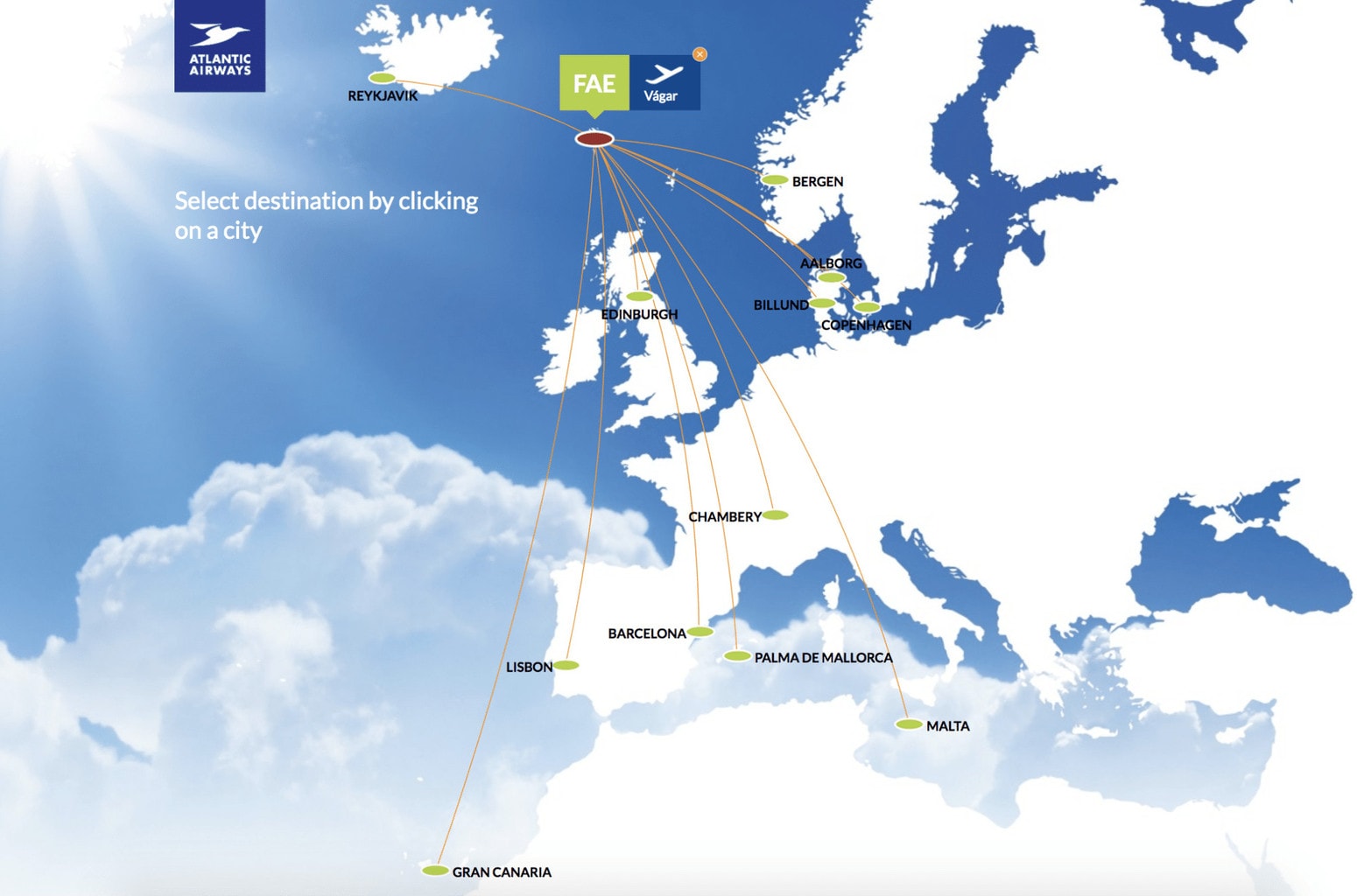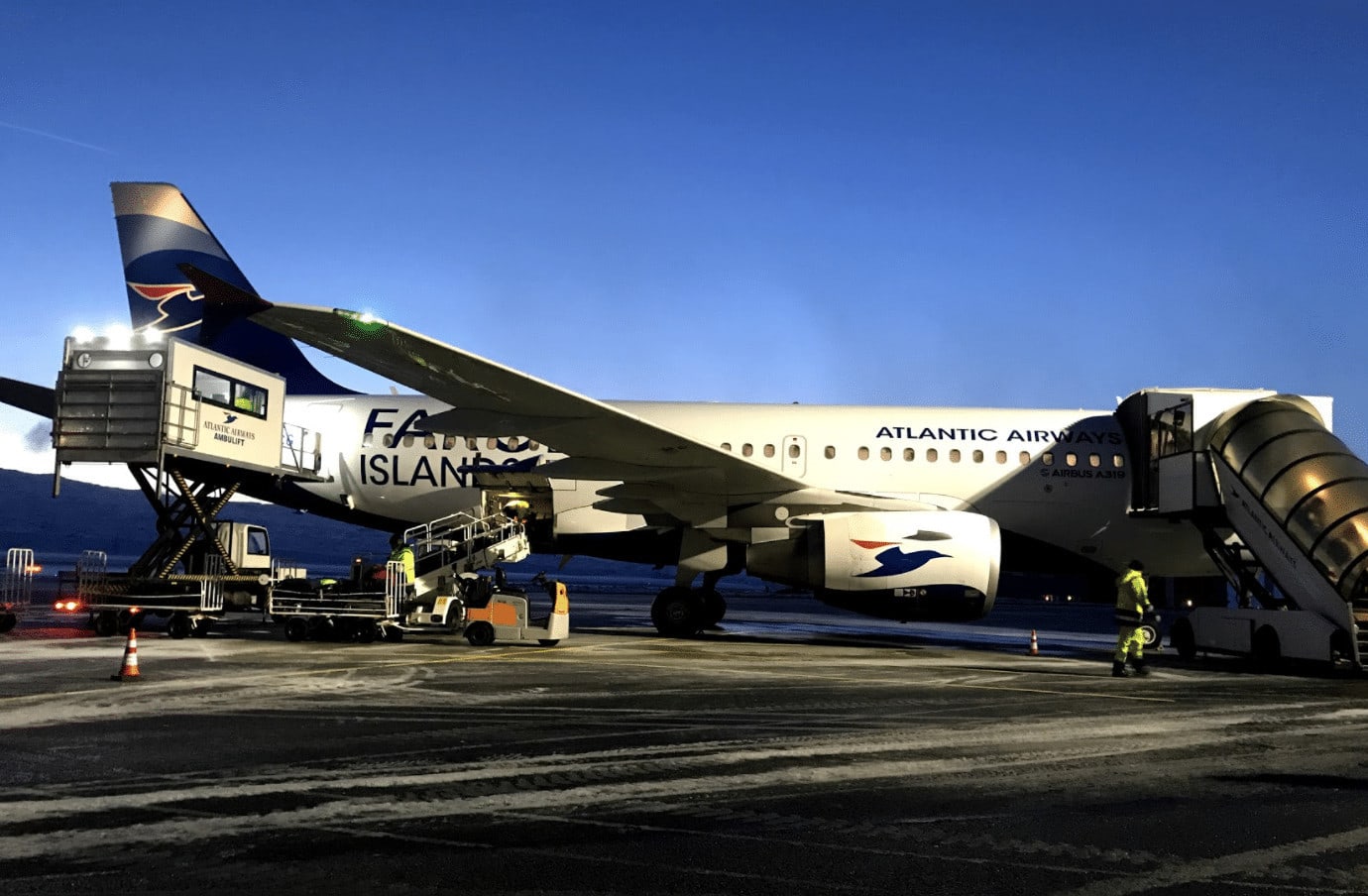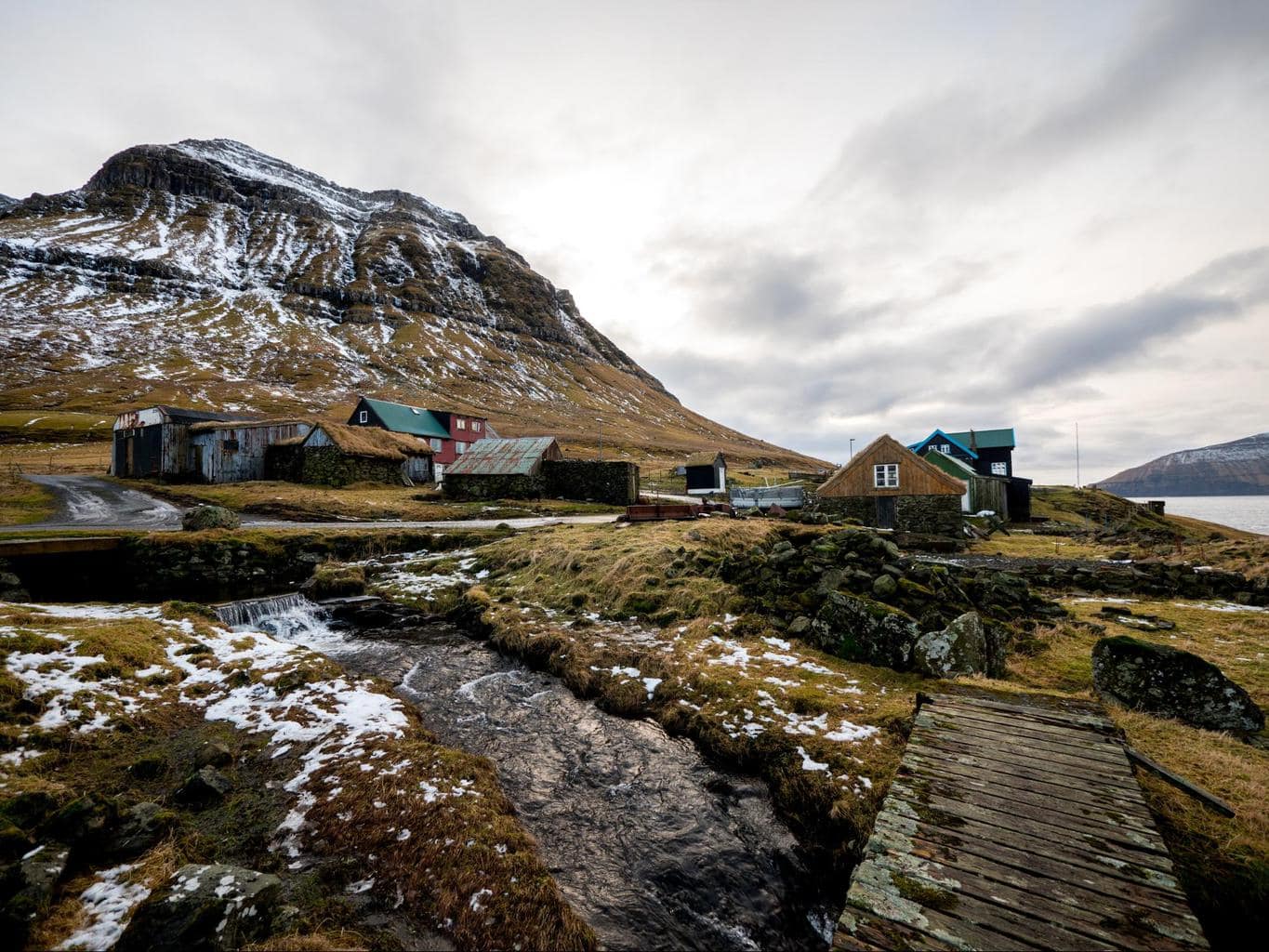The Faroe Islands is one of the least visited most remote parts of Europe and also one of the most naturally stunning. When you visit the Faroe Islands you’ll discover such incredible and breathtaking landscapes that you will hardly be able to compare them to anything else you’ve seen.
A trip to the Faroe Islands is like a journey to a parallel world of volcanic islands, cliffs jutting from the sea, surreal angles that seem to be playing a visual trick on your eyes…
Faroe Islands travel is an easy means to get away from it all for the islands have more sheep than people and you are never more than 5km away from the ocean.
Watch my video that captures the beauty of the islands here:
Where are the Faroe Islands – Maps and location
The Faroe Islands is a group of 18 independent and self-governing islands that are a territory belonging to the Kingdom of Denmark. They are located in the North Atlantic Ocean to the south of Iceland, the north of Scotland and West of Norway.
If you try to find the Faroe Islands on a map you may struggle because they are tiny. Here is a map of the Faroe Islands where you can see all the islands and the main roads and ferry routes connecting them.
The map above above is scanned from the one we used while on the ground to plot our Faroe Islands travel itinerary. They are available pretty much at every hotel and tourist spot and included in the small but handy brochure the Tourism Office issues.
The map shows that most of the islands in the Faroe are connected by underground tunnels, some of which take over five minutes to drive, short bridges or, in some occasions, ferries.
The long underground tunnels are really impressive. They dip down, cross the ocean and then the road climbs back up.
History of the Faroe Islands
The Faroe Islands are said to have first been inhabited by Irish monks in the 6th century who were looking for a peaceful retreat away from it all. It is obvious that they found that.
About 100 years later, the islands were colonized by Norwegian Vikings who made it a central part of their empire. Their Parliament can still be seen today, in Tinganes, in Torshavn.
The name was originally Faereyjar and first appeared in 1225 but was given by the Norwegian Vikings in the 9th century to refer to the “Sheep Islands”.
Aside from the cultural and human development on the islands, the natural development is worth a few paragraphs. From a geological standpoint, the Faroe Islands are made of volcanic basalt and give the appearance of being tilted from the west to the east, with sharp cliffs on the western side and rolling shores on the eastern.
The islands were created some 60 million years ago by the eruption of several volcanoes. Each eruption brought in a new basalt layer that sandwiched the layers of ashes from the previous eruption.
This volcanic land mass used to be covered by trees, but they disappeared when the first settlers cut them for wood and were never replanted. As a result, the Faroe Islands are devoid of any trees, giving the hills, cliffs and mountains covered in grass and moss, an even more dramatic look.
The rock formations and incredible landscapes have given way to an infinite number of legends where elves, witches and magical creatures play a central role. Every unique shape comes with its own tale, every inexplicable natural phenomenon has a magical explanation. The Faroe Islands are the playground of grown up tale tellers.
Since 1948, the Faroe Islands are a self-governing nation under the external sovereignty of the Kingdom of Denmark.
Despite being a part of Denmark, the Faroe Islands is not a part of the European Union, which explains its complex visa situation. Here is an article that explains further about how many countries there are in the world and if Faroe Islands and Greenland are included in this list.
Tourism in the Faroe Islands
With less than 50,000 inhabitants and less than a dozen hotels, tourism in the Faroe Islands is minimal, especially in the winter when the weather is sub-zero and the mountains are covered in snow.
The tourism infrastructure is seasonal and well developed only in the summer months. Even then you will feel like you have discovered one of the least explored parts of Western Europe.
I wondered how many people visited the islands and if it would feature on the list of the Least Visited Countries in the world, so I did a little investigation.
The Faroe Islands only had 160,000 bed nights in 2016 according to the Tourism Office numbers, but this number has been increasing by about 35%.
Of these bed nights, around 20% were taken by Faroese returning home. There are over 20,000 Faroese living abroad (mostly in mainland Denmark). Danish also made up 30% of the hotel nights. That means that less than half of the hotel nights were occupied by foreigners.
If one considers an average trip of five nights, that leaves only about 20,000 foreign visitors a year proving the point that the Faroe Islands is one of the least visited places in Europe.
However, don’t let this deter you. If anything, I hope this guide will make you want to visit it more after reading. The tourism authority actually closed the island to tourists in April 2019 to conduct some TLC and maintenance like new walkways, erecting viewpoints, and placing more signage in well-trodden paths to make a visit that much more convenient.
To help you organise your time and activities while on the island, the Tourism Office of the Faroe Islands has offices in most of the large islands usually manned by friendly and useful folk. Even the small islands have an office that is ready to help. Or you can also book a Faroe Islands tour.
Here is the list of regional tourism offices:
Things to do and see in the Faroe Islands
The majority of the activities on any Faroe Islands travel itinerary happen outdoors because nature is the Faroe Islands’ best and most unique feature. The volcanic mountains, the waterfalls, the sharp cliffs, the rock formations. The Faroe Islands look stunning from every angle.
There are a lot of hiking trails, trekking opportunities and stunning viewpoints that need to be absorbed, enjoyed and experienced. No matter how many breathtaking photos I show you, the best Faroe Islands vacation is the one you will have on the ground.
So let me shortlist a few of the best activities and things to see when you visit the Faroe Islands, so you can start planning a trip. Bonus: check out these interesting facts about the Faroe Islands that will give you some really great insight into the area before you visit.
Day trip to Mykines
Mykines is perhaps the best known part on any visitors Faroe Islands travel itinerary. The funny-looking cute puffins draw tourists in hordes to Mykines where they can be found in large groups during the summer months nestled in burrows in the clifftops.
Apart from the rich bird life, the hike to the lighthouse is another favourite.
Getting to Mykines requires you to take a helicopter or a ferry, neither of which runs in the winter months because of rough seas and wind. Even in the summer, you can easily get stuck if the weather suddenly turns, as it often does on the islands.
Road tripping the Faroe Islands
One of the best things to do on the Faroe Islands is to just simply drive and enjoy the many viewpoints along the roads.
In five days, I drove almost 1,000 kilometers.
Bear in mind the speed limit is only 80km/hour outside of urban centers and the roads can be very narrow and windy so you won’t be driving very fast. Also, if you go in the winter, the roads may be covered in snow or ice.
The tourism office edits a map of the Faroe Islands that has all the scenic roads and viewpoints marked on it. These roads, which have a flower icon on them and are green in color, are the perfect easy way to enjoy the best routes and views. Check it out below.
Some of my recommended ones are the one that runs from the capital all the way north, it climbs up to higher altitudes and you can stop along the way for lovely views of the valley below on both sides. The windmills, dancing to the strong winds that grace the islands, are majestic to see.
There are other interesting rock formations and places to see that are nice to include in your itinerary. Here are a few of the interesting landmarks that you should check out during your roadtrip when you visit the Faroe islands.
- Trøllkonufingur translated as “troll-woman’s fingers” is a loose rock at the end of a finger-looking 313 meter tall rock. The name was given by the locals because they said that it was the hand of a troll woman coming out from the sea that was trying to grab the Faroe Islands and throw it to Iceland. Legend has it that the rock claimed the life of a climber who, after having made it to the top, climbed down, only to forget his glove. He climbed back up to retrieve the glove and fell to his death. The rock has successfully been climbed a few times.
- Risin & Kellingin, the witch and the giant, are two rocks off the coast of Eidi. Legend has it that an Icelandic king sent a giant and his witch wife to the Faroe Islands to steal them for Iceland. They tried to tie a rope around a rock but as they pulled it, it broke off. Busy as they were to work out how to steal the islands, they forgot that the morning was coming. As they are creatures of the night, the sun rays turned them into stone.
Explore Torshavn
The capital of the Faroe Islands takes its name from the Nordic God of War, Thor, but is a quaint and pretty looking city on the ocean shores spread over a semi-circular bay.
As the most developed part of the country, you can find everything here, but do not expect major modern developments. There are only three traffic lights here and the locals still wave good day to passers-by.
However, the old and the new coexist happily in Torshavn and you can see the typical grass turf roofed houses next to modern condominiums. It is a city that blends Nordic influences, with hip stores and locally produced items, and a certain Ikea feeling that is so recognizable to visitors from abroad.
Torshavn has a few landmarks worth half a day of exploration. Here is a list of the main sights in the Faroese capital.
Torshavn Harbour Vagsbotnur
The city’s harbour is a great place for a stroll. There are a number of cafes, pretty wooden fishing boats, produce for sale, stores selling the typical wool sweaters with patterns that are so well-known and colourful facades of many buildings. It’s very quaint here and you may feel like you are a bit in your own fairy tale.
Tinganes
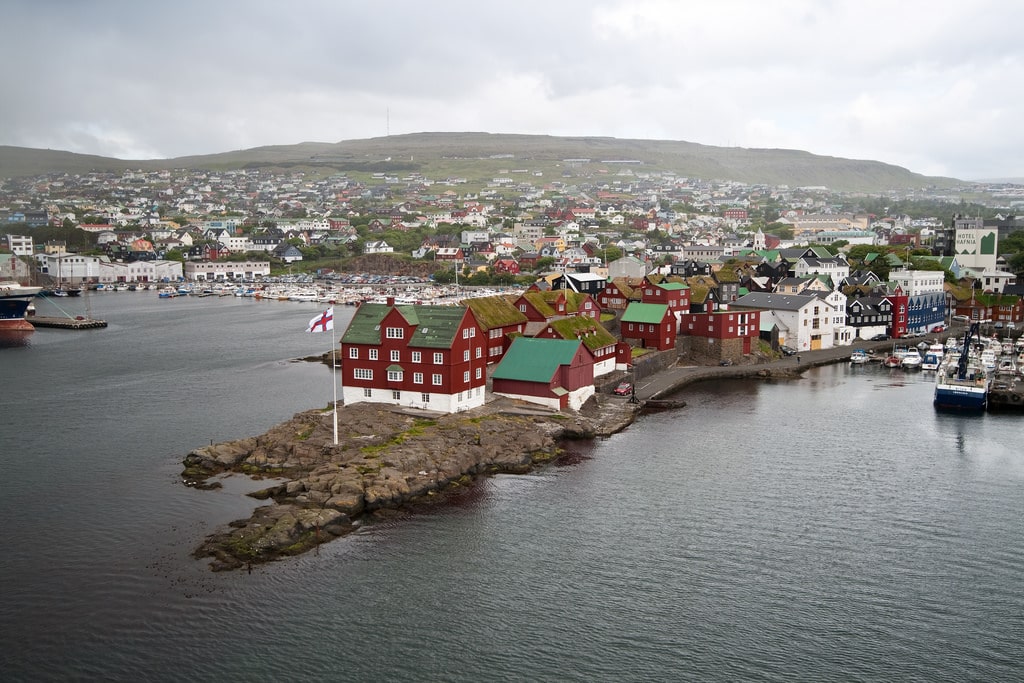
From the harbour stroll to the most famous part of Torshavn: Tinganes, the place of the old Parliament and the new government buildings. The red buildings with grass roofs are pretty and the narrow alleys are characteristic of a time gone by.
Torshavn cathedral
The cathedral in Torshavn, known as Dómkirkjan, is a landmark of the city. Built in 1788, it belongs to the Evangelical-Lutheran National Church of the Faroe Islands and is the seat of the Faroese bishop.
The cathedral’s altarpiece is from 1647 and a simple example of Renaissance art.
Inside the cathedral, the designs are modern and unlike other European religious churches. Walk in to have a look.
Other landmarks in and around Torshavn
I have marked a few other places in the map of Torshavn that might be worth taking a look. Here is a list:
- Steinprent is a graphic workshop with works on display, but the buildings used to house the first Faroese factory, Ostroms which produced fish oil.
- National Museum, for a bit of history, changing exhibitions and a warm place to escape to if the weather is harsh!
- Nolsoy is an island in front of the capital. It can be accessed by a ferry that crosses the waters in 20min. There are a few every day. Once there, you can hike to the lighthouse, enjoy some local food at Maggie’s cafe, buy sweaters designed by the locals, or see the Storm Petrel birds, a nocturnal animal that can be visited by the hands of the local taxidermist Jens Kjeld Jensen who organises night excursions in the summer months. You will not be able to see the birds, but you can hear them.
Explore small and quaint towns
You’ll see when you visit the Faroe Islands that they are filled with quaint villages made of wooden houses, grass roofs and red window frames that look like they have been taken out of a perfect postcard picture or a scene from The Lord of the Rings.
Some of these houses, wrapped around the mist that is so commonplace in the Faroe Islands, looks like they may be inhabited by magical creatures.
If you include a road trip on your Faroe Islands travel plans, exploring the many villages is the best way to see the country, especially in the winter months when the options for water or air borne activities are non-existent.
I enjoyed stopping by at all the idyllic villages and exploring their wild rugged magic. Here is a list of the best villages in the Faroe Islands worth a trip.
Gásadalur – Vagar Islands
Gásadalur, best known for Mulafossur waterfall, is one of the Faroe Islands’ most recognizable spots. The village is very picturesque and can only be reached via the relatively new one-way tunnel that was blasted through the mountains in 2004.
The village sits atop a plateau, in a valley, surrounded by towering 700-800m high mountains at either side. It is well known for the fact that, until the tunnel was built, the village was completely isolated and getting in or out required hiking across the mountains which the postman used to do every week.
The area can be extremely windy, as I discovered, and the path down to have the best view of the waterfall is muddy and slippery (especially when frozen) so be careful.
The fishermen living here have it very tough as the landing point is higher up and to get down to the beach they need to brave a steep staircase built by the British in 1940 during their occupation of the islands in WWII.
The area is said to be named after the geese that come here, or after legends of spirits and elfs. Because of its remoteness, Gásadalur is inhabited by around 20 people, so most of the quaint Faroese houses are uninhabited.
Sandavagur – Vagar Island
Continuing on your Faroe Islands travel route, on your drive from the airport to Torshavn you are likely to drive past Sandavagur. The village is recognizable thanks to its pretty red-roofed church that stands tall by the stream, the fourth church to be built in the same location. But there is more to this small village than just the church.
Sandavagur is an old settlement believed to have existed since Medieval times thanks to old stones with writings.
Although the village is not very big, there is a pleasant historical walking tour that has been put together by the local authorities and which tells of the history of the area. These are a few things to see in the village:
- Sandavagur Church is recent, built at the beginning of the 20th century and it is the forth that was erected in the same location. Aside from the Nordic facade, the red roof is recognizable from the road. The church is slightly elevated and surrounded by the cemetery as is tradition. Inside, you can see paintings and an altarpiece made by local artisans. The church is surrounded by a stone wall which protects it from sea erosion.
- Runic stone is proof that the village existed in 1200 AD as the writings date back to that time and are believed to be from the Torkils. The stone is found inside the church.
- Hammershaimb memorial was erected in commemoration of the 100th anniversary of his birth. Hammershaimb is believed to be the father of the Faroese language and wrote a book on the orthography of the language when he realised that the oral tradition of the Faroese language was evolving into a multitude of dialects.
Slaettanes – Vagar island
This village is a good example of how Faroese used to live and will provide insight on the culture and history when you visit the Faroe Islands.
The village is abandoned today but you can still see how people lived for over a century when the village was inhabited.
The town was founded by Hendrik Thomassen, an experienced sheepherder who was sent to the area when the local sheep had to be tamed. He liked the area and settled there. With time, against the original reluctancy of the locals, more families moved in. Because the village was so isolated, the priest only came once a year and provisions had to be brought by boat, rowing from Vestmanna.
At its peak, Slaettanes had 75 inhabitants but its demise came when the electricity company advised them in 1964 that they would never bring electricity over. As a result, the residents all emigrated and the village became a ghost town.
Bøur – Vagar Island
Boeur (Bøur in Faroese) is another small village on the way to Gásadalur worth a stop. From here you have lovely views of the islet Tindhólmur. The village has 75 inhabitants, making it one of the largest in the Faroe Islands.
There are a lot of stories and legends around Boeur which explains why the land in this village is entirely owned by the Danish royal family, some of which talk about stolen fire or brotherly murders.
Nordradalur – Streymoy Islands
This very tiny village is not even on Google Maps, or rather it is marked in the wrong place, but I marked it correctly on my map in this article. So you should definitely save it for offline use when you visit the Faroe Islands.
I very much enjoyed stopping by. There were many curious sheep and a dog that came over to greet us, smell us and look at us as soon as we got out of the car and the views were stunning, even the snaking road down was impressive.
Kirkjubøur – Streymoy Islands
This village near Torshavn, the capital, is one of the most picturesque because of its genuine Faroese architecture and its position along the seashore. You can drive the 15mins to get there from the city, or walk for two hours across the mountain.
Kirkjubøur was the Medieval cultural and religious center of the Faroe Islands and this is obvious in the various remains.
The oldest church in the Faroe Islands, St Olav Church, and the Gothic St Magnus Cathedral nowadays called Muren and currently half in ruins half renovated are both located here.
The cathedral was built in the 14th century and many of its decorative features and elements are on display at the National Museum. The church, believed to be the only one from the Middle Ages is still in use.
The ruins of the cathedral are next to the oldest wooden house in Europe, dating from the 11th century and located in a dramatic seaside location. The house is called Roykstovan and was the King’s Farmhouse. It was built in Norway, dismantled and brought in pieces to the Faroe Islands. It is still inhabited by the Partusson family.
The oldest part of the house, Stokkastovan, is open to visitors. The door is always open, just push it in. There is a donation box to leave your contribution, and stepping inside is mystical.
I went to Kirkjubøur as the sun was rising and it was stunning, probably the most spectacular sight on my Faroe Islands travel itinerary.
Koltur – Streymoy Island
This small village has the only white sand beach in the country, but do not expect the fine sand beaches of Southeast Asia. There are rocks leading out to the sand. It is nonetheless an incredible sight in such a rough and volcanic place.
Reaching the island requires a private tour so you will need to check with the tourism office of Torshavn to see options available.
Saksun – Streymoy Island
Saksun is a tiny village of 14 inhabitants that follows Faroese architecture and sits on the shores of a tidal lagoon. It is as remote as it gets when you visit the Faroe Islands, over an hour’s drive from Torshavn, but it is worth a visit for its pretty location and its church, dating from 1858. An old farm, Dúvugarðar, is today available for visits as a museum although it still is a functioning sheep farm.
Tjørnuvík – Streymoy Island
Arriving at Tjørnuvík feels like arriving at the end of the world.
The scenic, not for the faint of heart, winding one lane road ends here, so your only way out is retracing your steps.
The waves lap on the black sand and pebble beach in one of the few places where the shore is not rocky but made of sand.
If you’ve come to visit the Faroe Islands for surfing, this is the spot to be. The bay is relatively protected yet the waves can be high. If you stand at the parking lot at the entrance to the village and look out into the ocean, the view over the jotting rocks and cliffs is stunning.
Haldorsvik – Streymoy Island
Haldorsvik is known for its eight-face church that is quite unique. On your way to the village, you can pas by the tallest waterfall in the Faroe Islands, Fossa.
Gjógv – Eysturoy Island
Gjógv is a little idyllic village that is a recognizable image of the Faroe Islands because of the gorge running into the village and the perfect houses all with the turf roof and the wooden walls.
Because of its picture-perfect look and efforts in preserving and respecting the environment, the village was nominated by the Nordic Council for the Nature & Environmental Award in 2014.
If you are visiting the islands in the winter, like I did, you may struggle to reach Gjógv because of its truly isolated location and accessibility along a very narrow, frozen and unmaintained path.
The signs at the entrance of the mountain road indicate it is not being maintained and there is risk of rocks falling and slippery roads. After driving for 15 minutes into the mountains on a road covered in snow, I decided it was best to turn around as I was worried we might get stuck or slide off the mountain side and into the lake.
If you get there, there is a teahouse and a guesthouse called Gjaargardur with a restaurant in the high season where you can base yourself if you want to explore all the hiking trails in the area or the highest mountain in the Faroe Islands, Slættaratindur.
Funningur – Eysturoy Island
As opposed to other villages located on the side of the rocky shores, Funnigur is set on rolling hills by calm waters and has great views of the islands and hills around.
Hiking in the Faroe Islands – Best hiking trails
People come to the Faroe Islands for hiking and you should not leave the islands without at least a couple of hikes. There are a lot of very easy ones which simply follow flat grass paths, and others which are long and steep, requiring hikers to be fit and experienced.
Although most of the hiking when you visit the Faroe Islands can be done on your own, following relatively visible paths, you can also hire a guide. There is a very well known local resource called Hiking.fo that provides a lot of information about all the hiking routes. Free booklets with all the hikes are also available in all major tourist places like hotels or the tourism offices.
Below I will highlight the best known, the most beautiful and the most recommended hikes in the Faroe Islands. You can also read more about them in my article about the Best hikes in the Faroe Islands.
Hike from Boeur to Gásadalur (2.5h, Moderate to difficult)
In the previous section I told you all about both villages. What better way to feel like the old inhabitants of Gásadalur than by hiking from the nearest village along the path they had to take to reach the nearest facilities and services? You can read more about the legends around the hike here.
Hike to Slættaratindur
The hike to the island’s highest peak can be done in 4h from Gjogv or in around an hour from Eiðisskarð. As the highest mountain, topping 880m above sea level, the mountain is a symbol of the country and it is a tradition to climb it on the longest day of the year, the summer solstice on 21st June, where hikers can see the sun set and then rise in just a few hours.
Hike to Tindhólmur
The hike is moderate to difficult with rocky paths, waves, wind, etc. and there is no clear path. Unlike the rest of the hikes, this one is only for the bravest and most experienced and can take up to a day so make sure to attempt it in the summer months.
You can also opt to see the formations from the sea on a group tour which you can book here.
Hike from Saksun to Tjørnuvík (3h, mostly easy with moderate to difficult parts)
Both quaint pretty villages, this walk takes in some of the most dramatic and unique places in the Faroe Islands along a grass pass. It is a great alternative to driving the winding road.
Hike Lake Sørvágsvatn / Leitisvatn (both names are used)
Lake Sørvágsvatn / Leitisvatn is the most well-known place in the Faroe Islands mostly because of the visual trick it plays on the eye from the ocean point of view where the lake looks like it is floating.
In winter, it looks like this, and as it was super windy, we could not fly the drone over the edge of the cliff to have the stunning view you see above. However, we did have it all to ourselves, not a rarity on our Faroe Islands travel journey, but pleasant nonetheless.
From the lake, a 35m waterfall cascades into the ocean but you may not be able to see it as you will be on top of it. Only the birds and maybe a drone have the opportunity to see it in its full glory.
You should definitely visit to have a real feel for the place, which the photos can never provide. The entire area is absolutely breathtaking, with waterfalls into the ocean, cliffs, birds and incredible viewpoints. Check this video out.
The hike is about 3h return but might take longer in the winter when many of the streams you need to cross are frozen and you need to walk on ice. If you have them, grampons will be extremely useful.
There is a small parking area in front of the tiny gate that leads onto the path. To get there, on your way from Torshavn, take the first left after the church and follow the signs. Leave the car and enter the path. It is pretty much a straight line to get to the edge where the cliff walls are. You can also return by hiking on the other side of the lake.
If you are not up for hiking or if you prefer a different view, there are lake boat tours on a boathouse departing from the village Vatnsoyrar.
Other sightseeing spots
Although it is hard to separate sightseeing from hiking or quaint villages, there are a few spots in the Faroe Islands that are worth seeing in themselves and which you should add to your Faroe Islands travel itinerary.
Klaksvík
The town of Klaksvík, the country’s fishing center, is the second largest in the Faroe Islands after the capital and it has an important church that was inspired by old Nordic style.
From the outside, the architecture contrasts with the rest of the traditional churches that dot the country.
We did not go in because there was a funeral at the time, but the building is worth it even from the outside.
After exploring the many villages and remote parts of the islands, Klaksvik is refreshingly developed and urban, albeit for Faroese standards. The view from the road over the towering mountains coming up from the sea is spectacular.
If you are into beer, one of the two breweries in the islands, Foroya Bjor, is located here.
Statue of the seal woman
The 3m statue of the seal woman can be found in the village of Mikladalur, on the island of Kalsoy, and it is a symbol of the Faroe Islands.
Legend has it that she is braving the wind and the rain to take one last look at her children which she left behind when she returned to the water after falling in love with a boy where she was forced to stay on land.
Other adventure spots in the Faroe Islands

When you visit the Faroe Islands, you’ll see that it has perfect roads and is a great destination for cycling lovers. However, beware that the winding roads and the steep hills are not suitable for beginners, and the harsh weather will require you to be prepared but if you are after an adventure of a lifetime, this is it.
Those into horse riding can do so on the island of Vagar. Short or longer rides are organised by Davidsen Haster.
For more adventurous souls, rappel down several cliff walls in many locations around the islands. The best way would be to contact the tourism office and find out the convenient tours while you are there.
Sailing to Enniberg
In the summer months, when the waters are calmer, you can sail out to Enniberg, the tallest cliff in the islands rising 750m from the ocean. This trip is a fantastic way to see the rich birdlife that inhabits the Faroe Islands and experience a different view of the dramatic cliffs.
Vestmanna bird cliffs
The Faroe Islands is well known for its rich bird population in the summer months and the Vestmanna cliffs are the right place to see them in action.
To enjoy this, you will have to join a boat tour which crosses the narrow cliffs and grottoes. Tours depart from the Vestmanna Tourist Center. You can book them here.
Make sure to check out the Saga Museum which is by the Tourist Center.
What and where to eat in the Faroe Islands, best food and restaurants
There are not a lot of restaurants on the Faroe Islands. In fact, if you do a quick search you will realise that there are less than a dozen restaurants that pop up on Google. After a hard day’s work hiking and exploring the islands, you will probably want to relax and have a hearty meal.
You have earned it and, remember, in the cold climate, your body will use more energy to keep you warm, so you can go for that Faroese meal without remorse.
The Faroe Islands cuisine is relatively restrictive due to the weather and the harsh conditions for agriculture. Most restaurants are located in historical buildings and have the warm feeling of fluffy sheepskin placed on wooden chairs.
Although there are quite a few more casual bars/pubs and small food places, the best restaurants in the Faroe Islands are the ones that everyone will recommend to you. Consensus is there.
Here is the list of all the restaurants you should try when you visit the Faroe Islands. On an average 5 day trip to the Islands, you are bound to have enough time to try them all, even more than once.
Koks
This is the Faroe Islands only Michelin-starred restaurant and it started a real Faroese cuisine movement with lots of in-depth articles written about its uniqueness and the difficulties of sourcing entire menus from the meagre and poor lands of the Faroe Islands.
Koks used to be located in the Foroyar Hotel with fantastic views over the capital of Torshavn and the bay below but moved outside the city in a beautifully rustic location in Leynavatn.
The restaurant is led by a young chef in his 20s who has a team of “foragers, farmers and divers” quotes the Financial Times, to source the ingredients for its dishes.
The volcanic and poor soil of the islands are not conducive to growing much. There are more sheep than humans who feed on the ever growing grass, even in the winter months when the snow can cover it all. But little grows underneath.
The landscapes are bare, stunning in rock formations and shapes, but devoid of vegetation. There are no trees on the Faroe Islands, something that happened when all the trees which once existed were cut and new ones were never planted.
The ocean is rich in marine life, and the salmon in the Faroe Islands is absolutely divine, but young chef Ziska is trying to do something incredible by making sure that all of his ingredients are sourced locally. This is probably why the restaurant is closed in the winter months, from October to April when practically nothing grows.
If you are around when it is open, Koks is the best way into the Faroese food scene and traditions which are hard to savour anywhere else.
Gras
Gras took over the location that Koks left when it moved and it offers the most panoramic views over the city of Torshavn and the bay below.
The restaurant has a breakfast and dinner buffet with international and Faroese dishes, and an a la carte light lunch menu but the views are the definitive reason to come here.
Aarstova
This restaurant has very limited options with only a menu per sitting with two choices for starters (smoked salmon or lobster bisque) and two for mains (cod fish or lamb).
They a known for the lamb shoulder which you only get in the shorter menu (the longer one has lamb chops instead of lamb shoulder) and which has been cooked slowly for 12 hours. It is so soft that the meat comes off the bone without the need for a knife.
Aarstova is located in an old wooden Faroese house in the middle of Torshavn and it is well worth a visit for the atmosphere, dimly lit and looking like you are visiting old friends. Service is attentive and, if you go for the wine pairing option, the wine will keep coming, so you are going to get almost an unlimited amount.
The wine list is made of only six producers which they have personally vetoed and visited. They have a selection of wines from these six producers.
Etika
Etika is a sushi restaurant in the Faroe Islands (the only one) that makes a lot of sense since the islands get some of the best and freshest fish there is.
The restaurant is located near Aarstova and gives you the opportunity to people watch as it is located along a main road and made of glass windows.
The menu is extensive, with dozens of options that you can combine and pre-set menus for two with everything you can think off. The food was excellent and they are also a good option for take away because they have a smaller selection of pre-set sushi/sashimi boxes you can pop in and buy and are as good as anything you’d find when eating the best Japanese food.
We ate in and made an order for take away to take with us for the next day’s hiking excursion which was a great idea, especially since it is so cold in the Faroe Islands all year round that the sushi keeps well even in the car.
Raest
Raest specialises in fermented cuisine. This may sound strange but it is typically Faroese. Similar to much of the Korean food items, in the past, locals would conserve every part of an animal by keeping it dried or fermented. As winters are harsh and there is little food, fermentation helped preserve it all.
Fermented meat, especially lamb, is a very typical Faroese dish. Although it is not my cup of tea, it is not bad, just a bit salty. This is because Faroese fermentation, unlike wet fermentation used in, for example, kimchi, is done in the open air, by drying the food in the salty cold air of the Faroe Islands.
Katrina Christiansen
Located in a historical building home to the most famous Faroese writer, Katrina Christiansen is a tapas-style Faroese restaurant where you can sample local dishes in the small plate format. The restaurant opened in 2016 only and is a great choice for something a bit different.
Toscana
If you feel like you want to have some lighter and more international cuisine, Toscana is the highest rated Italian restaurant in the Faroe Islands for your fix of Sicilian food.
Dine in the homes of Faroese locals
An evening at a Faroese home is one of the nicest and best ways to experience local Faroese food: Heimablidni.
Heimablidni is a supper club of sorts where a Faroese couple, Anna and Óli, will offer you the chance to have the most authentic experience with a 5-course meal that includes all the best that the land can offer: homemade bread with sausage (Anna’s grandmother’s recipe), homemade rhubarb juice and lamb raised on their own farm. You can book here.
Where to stay in the Faroe Island
I always found it quite interesting that, even in rooms with double beds, there are two duvets folded on top of the sheets, one for each of the guests. This is something that I also experienced in Iceland, other than the Bubble Hotel, so perhaps a Nordic tradition that escaped me.
There are only 11 accommodations classified as hotels, none of which is a 5 star hotel, and four hostels in the Faroe Islands. Additionally, there are also seven guesthouses. That means that your choice will be limited.
However, I have put together a list to help you choose the best ones to match your budget, itinerary and interests.
If you are planning to visit the Faroe Islands for longer than five days, it might make sense to include some other accommodation options beyond Torshavn, like the island of Vagar or Gjogv, but if you are only staying for five days, I would recommend you stay at the same hotel in Torshavn.
Why you should stay in Torshavn? Because it will be the most convenient.
Torshavn has most of the restaurants mentioned above, so you will have more dining alternatives. It is also more central than other towns like Vagar, so it will be easier to explore the islands. And Torshavn is worth a day exploring the harbour, the parliament area and the museums.
Foroyar Hotel

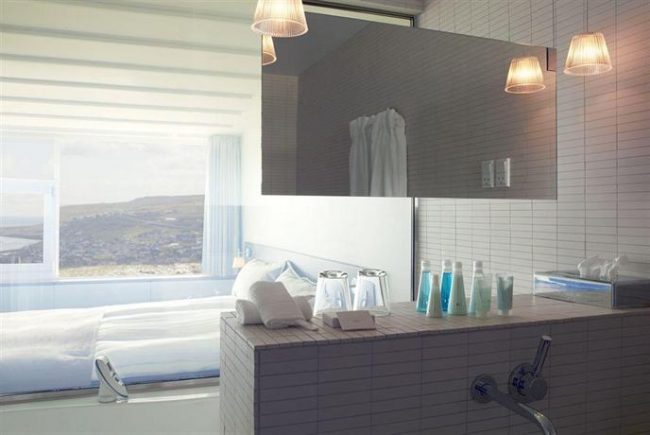
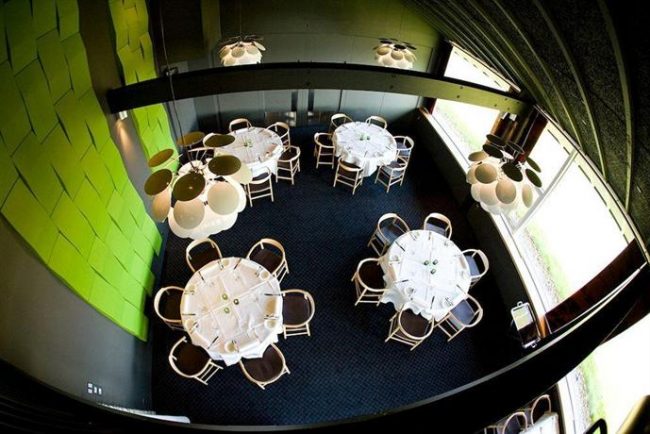
Located in the outskirts of the city, high atop a hill, Foroyar Hotel is the highest rated hotel in the Faroe Islands. Although they bill themselves as the country’s only four star hotel, I think it is more a 3,5 star mostly because the rooms are nothing special.
The hotel has full facilities, including a gym, and the restaurant with the best views in Torshavn. There is also a bar and meeting rooms. The reception is 24h and can help out with anything. There is a small fridge which sells snacks and sandwiches, as well a small selection of sushi from Etika.
When the rest of the country is closed off, aka during the Christmas holidays, Foroyar Hotel is the only place open so most foreigners congregate there.
All the rooms at Foroyar Hotel have the same views as the restaurant, and a stunning perspective over the bay and the city. The hotel’s turf rooftop is a welcome touch.
For more images, rates and availability check out Agoda
Hotel Hafnia



A good hotel in the downtown area of Torshavn, within minutes to all the restaurants mentioned in the food section above, with warm hues, light wood and colorful decor. After Hotel Foroyar, this is the next best hotel in the Faroe Islands.
Hafnia is closed during the Christmas period.
For more images, rates and availability check out Agoda
Hotel Torshavn
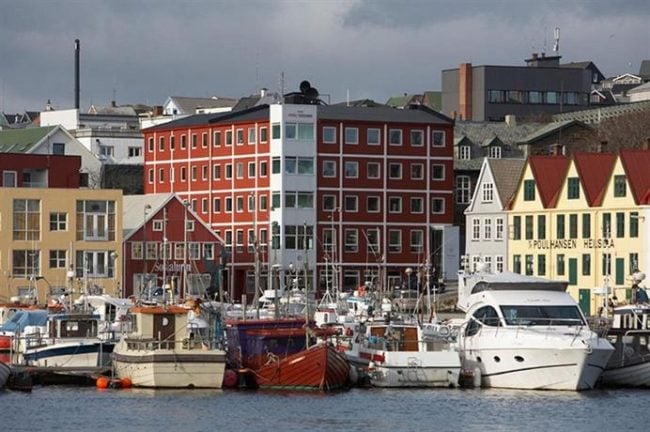

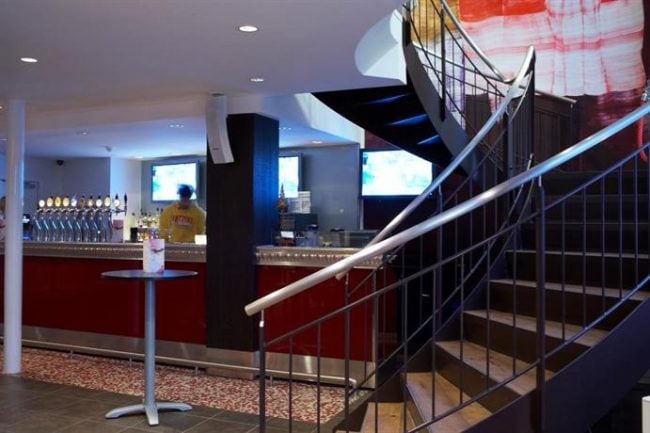
Another local favourite in town by the harbour this is a scenically located hotel with nice views over the fishing boats.
Its location by the ferry area is convenient for daily excursions during the summer months.
The hotel was renovated in 2007 from its 1923 former seamen hostel glory, and is now a modern 3 star hotel in burgundy, red and orange tones. The hotel is open all days of the year, there is a bar and brasserie available.
For more images, rates and availability check out Agoda
Hotel Vagar



Not in Torshavn, but if you need a night near the airport, Hotel Vagar is right by the terminal. It is a house in a rather industrial looking one-floor building but conveniently located and comfortable.
The hotel, and the island, might also be a good option to split the trip if you plan to stay longer in the Faroe Islands as the island of Vagar has a lot of hiking trails and sightseeing opportunities and is a good 45min drive from Torshavn. So by staying there you would be saving almost 2h drive (which is a long time in the short daylight winter months).
For more images, rates and availability check out Agoda
Guesthouse Gjaargardur in Gjogv
If you are planning to explore the area around Gjogv, especially the hike up to the highest mountain on the islands, a night in the guesthouse in Gjogv is a good idea.
This guesthouse is a cozy, family-run, warm place to stay. The rooms are comfortable, the family running it are well on top of things to make sure guests are happy and meals are local and hearty. It basically has everything you need for a great night and a side of views and local life.
For more images, rates and availability check out Agoda
How to get to the Faroe Islands
Although the Faroe Islands may seem remote and isolated, they are connected to mainland Europe, the UK and Iceland by plane and in the summer months, there are cruise ships that explore the North Atlantic Ocean which stop in Torshavn and other places.
The best flights to the Faroe Islands
The airport in the Faroe Islands is located on the island of Vagar, code FAE, and is the best way to get to the islands. The airport was built by the British Army during WWII when the country needed a base in the North Atlantic Ocean. After the war ended, the airport went into disuse until the 60s when an Icelandic airline started flying there.
The national Faroese airline, Atlantic Airways, started operations at the end of the 1980s when the only route connecting the Faroe Islands to the rest of the world was a passenger flight from Iceland to Denmark, making Faroe Islands travel pretty convenient.
Atlantic Airways connects Vagar with several cities in Europe including Edinburgh, Copenhagen (2.5h), Bergen (2h) and Reykjavik (1h and 20min) regularly. This means that you can combine Iceland and the Faroe Islands for the ultimate nature, landscapes and hiking trip.
The airline also provides summer escape opportunities to the Faroese by serving Lisbon, Barcelona, Mallorca, Malta and Gran Canaria seasonally once or twice weekly and is in charge of the two helicopters which connect the remote islands via a subsidized service.
Another option to get to the Faroe Islands is to fly Scandinavian Airlines (SAS) from Copenhagen on their daily flight. The flight started in 2017 as demand increased, and adds to Vagar Airport’s passenger capacity.
I flew Atlantic Airways from Iceland (codeshare with Icelandair but operated by Atlantic Airways) to the Faroe Islands and then on to Copenhagen to connect with my flight back to Barcelona on SAS. I found them both similar in service and since they are short flights, it did not really matter much.
Check in at the airport in Vagar opens 1.5h before the flight so there is no point in arriving earlier. Inside the airport there is a small cafe, offices of the car rental companies, an information store and toilets.
If you find yourself in the Faroe Islands in a marked public holiday when everything is closed (like the 1st of January) the airport cafe is likely to be the only food option in the entire archipelago.
Once you are through with your boarding pass, there is a relatively large duty free shop where you can buy the famous Faroese Aquavit and other liquors and enjoy a bite at the Mirror Cafe. There are only three boarding gates at the airport and it is unlikely that more than one will be in use at the same time.
Cruise ships docking at the Faroe Islands
There is a cruise between Denmark and the Faroe Islands from Smyril Line that covers the North Atlantic Ocean on a week-long trip with two stops in Torshavn and once in Iceland. The trip claims to offer a view of the islands as the Vikings saw it centuries ago. Although a lot of time is spent at sea, traveling to and from Denmark, this is a cruise that is mostly focused on these Viking lands.
A lot of the large well-known cruise ships also stop on the Faroe Islands but the call is more of a quickie than anything in-depth and will probably only give you a taste of what the Faroe Islands travel is really about.
If you have time and wish to explore the North Atlantic Ocean area and the Faroe Islands more in-depth from the water point of view, you can join one of the expedition cruises that explore that part of the world.
One of the most well known and established expedition cruise ships stopping at the Faroe Islands is Quark Expeditions. They have several itineraries stopping on the Faroe Islands in their expeditions to Greenland, Iceland and the Arctic areas would be much more suitable to those wanting to truly understand the Islands.
However, I would strongly suggest to spend some quality time in the Faroe Islands. This is not a place you can understand, enjoy or explore on a quick one or two day trip. The best way to really experience it is by spending some time trekking the paths, hiking the trails and enjoying the food. A cruise ship would be a shame unless it spends some quality time on the Islands.
Getting around – Road rules and car rentals in the Faroe Islands
One of the most convenient ways to explore the Faroe Islands is from the comfort of your own rented car.
There are public buses linking most of the towns but without a car, you will be very limited in your ability to explore the islands.
However, I was shocked to see the prices of some of the rental companies who were quoting me almost $1,000 for five day rentals. There are a few of these. The most affordable rental car company in the Faroe Islands is Avis, which is also the only international rental car available when you visit the Faroe Islands. Car rentals are picked up and dropped off at the airport.
Avis has a counter by the arrivals/departures area and the staff there are most unfriendly. But alas, we did not need much conversation with them. Getting the car was easy and the parking is right in front of the exit. If you go in the winter, the wheels will already be studded so you can easily drive on ice and snow.
You do not need to rent a 4×4 and, in fact, I did not see them available on their website or parking lot. I booked the smallest car available, a Kia Picanto, and it was just fine, if struggling a bit when going uphill over the many mountain passes.
On a practical note, many of the villages in the Faroe Islands have facilities for road trippers and visitors that are available throughout the country and are free. Clean toilets can be found in most relevant villages.
The doors are open and signs usually point at them from the main roads. You can also find out what facilities are available at each village on the Tourist Guide edited by Faroese Tourism and are available across the country.
Driving in the Faroe Islands
I found the roads to be in great condition, but driving in the Faroe Islands is different than in other places because of the unique geological conditions and the many tunnels. Some of these tunnels are only one way and some of the roads are so narrow that two cars cannot drive in parallel.
For this reason, there are a few things you need to know before driving in the Faroe Islands. Here are some useful driving tips:
- When the road is a single lane, even inside tunnels, there are openings on the road every 100 meters for one of the cars to wait for the oncoming traffic to pass. The car for whom the space is available is the one who should get in it and let the other car pass.
- If the one lane road is on an incline, the car going down is the one who needs to stop and give way to the car driving uphill.
- There are tolls on the most relevant tunnels which need to be paid at the petrol stations. However, if you have a rental car, the car company will pay it for you and send you a final bill.
The government of the Faroe Islands has prepared a video about driving on the islands to make sure everyone knows the driving rules.
Lastly, it is good to note that there are many petrol stations available most of which are marked on Google maps.
However, when you are trying to fill the tank on a public holiday, you will have to look out for the stations that have self-service credit card enabled machines. We struggled with this because the machines would only accept cards that had a PIN and our Singapore credit cards do not have them. We ended up having to use the debit card. Alternatively, we were ready to offer cash to a goodwill passer-by in exchange for using his card.
Weather in the Faroe Islands and best time to visit
The weather in the Faroe Islands is stable and similar all year round because of its location far north. That means that, on average, the islands are between 3 and 11 degrees celsius, all year round with only 10 degrees difference between winter and summer.
However, stable does not mean warm. The Tourism Board website claims that the islands once recorded 26 degrees Celsius.
Looking at the historical average temperatures and rainfall one can assume that winter clothes will always be required, even in the middle of the summer months when the maximum temperatures recorded are well below the average winter in Barcelona!
Check out my graph of the average temperatures and rainfall per month made using this data.
So, what is the weather like in the Faroe Islands? I would say it is wet, windy and cold all year round and you can be sure of that.
The best time to visit the Faroe Islands
The best time to visit the Faroe Islands is during the summer months. This is when the weather is at its best and when there is more activity and options to explore the islands. In case there are any doubts left, here’s why you should visit the Faroe Islands in the summer:
- Temperatures are above zero. Even if the recorded temperatures in the winter are also usually above freezing point, you need to account for the wind that always blows. That can easily bring the temperatures down by another 10 degrees. The wind chill factor is an issue to consider in the summer too, so bring adequate clothes.
- There are more hours of sunlight. In the winter months the sun can rise at 10am and set at 3,30pm around the winter solstice. That means that most of the day is in the darkness and given the many outdoor activities you can do in the Faroe Islands, you really want to be able to be outside and in the sunlight for as long as possible.
- There are more things open. In the winter, especially during the Christmas period, a lot of the restaurants and hotels are closed. The ferries don’t run. The helicopter service between islands is not operating. Many excursions are not possible and the tour guides are all on leave. That means you won’t be able to see or do a lot of the things that are otherwise available in the summer.
- There are several festivals. In June, there is a Culture Night in Torshavn and on 28th and 29th of July the national celebration to King Olav the Holy takes place. See the calendar below, edited by Visit Faroe Islands and included in their Visit Faroe Islands brochure. It pays to visit the islands during one of the festivals for an extra dose of culture and insights into local life and to interact with the Faroese.
The Faroe Islands in winter time
Despite summer time being the best time to have the full Faroese experience, I went in the winter and we had the whole place to ourselves.
We were one of the few tourists in the entire set of Islands for the duration of our trip. We did not see any other tourists on our Faroe Islands travel itinerary except for maybe a couple of them at our hotel and maybe one or two business travelers.
However, many of the restaurants and hotels in town were closed and there were so few options available that we ended up eating at the same place more than once and we even had lunch at a petrol station and at the airport for lack of other options available on the 1st of January.
If you are in the Faroe Islands over New Year’s Eve, like I was, you will be witness to one of the coolest celebrations. The entire city of Torshavn and the villages set the sky on fire with hundreds of thousands of fireworks from every house and street and the sky above the city was lit for hours non-stop.
I have never seen something like that and it gave celebrations like the one in Sydney a run for their money. It was spectacular to see the amateur and uncoordinated fireworks display from atop the roof of the Foroyar Hotel, located up in the hills above Torshavn.
If you happen to be there during Christmas, the Tourism Office has a section on their site about what to expect. But most of it will be over after Christmas. It is safe to say that the time between Christmas and New Year is the quietest and slowest time of the year.
Practicalities and other things to know for your vacation in the Faroe Islands
We have gone through a lot of information about the Faroe Islands but there is still a bit to cover in terms of practicalities to make a trip happen.
The Faroe Islands is part of Denmark and, as such, the currency in the Faroe Islands is the Danish Krone. You will not be able to use euros there but can easily exchange them. ATM machines are available throughout the country.
The Faroese language is not the same as the Danish but locals speak both. To a foreigner, it is hard to differentiate which language has been used as they both look and sound very unique.
Faroese comes from Old Norse and is related to Icelandic, Norwegian, Danish and Swedish. This is the reason why a lot of the locals can also understand other Nordic languages. Much like any speaker of a Latin language can understand another. English is widely spoken by everyone and you will not have any communication issues.
Visa for the Faroe Islands
For Europeans, the Faroe Islands is not part of the Schengen but can be visited with just a picture ID. However, visas for the Faroe Islands do not work like other Schengen visas or even visas for Denmark.
Even if you are allowed to visit Denmark in your visa, that does not mean that you can visit the Faroe Islands.
Here is a detailed list of the peculiar visa situation in the Faroe Islands.
- Nordic country citizens can enter freely with a picture ID.
- Citizens of the following EU countries: Austria, Belgium, Bulgaria, Croatia, Cyprus, Czech Republic, Estonia, Finland, France, Germany, Great Britain, Greece, Hungary, Italy, Latvia, Liechtenstein, Lithuania, Luxembourg, Malta, Netherlands, Poland, Portugal, Romania, Slovakia, Slovenia, Spain, Sweden, Switzerland can enter with a picture ID. Other EU residents and citizens need a valid passport.
- Danish residents not included above need a visa for the Faroe Islands and vice versa. A visa to Denmark does not grant access to the Faroe Islands unless specified, and a visa to the Faroe Islands does not grant access to Denmark.
- To obtain a visa to the Faroe Islands one needs to follow a similar process to getting a visa for Denmark. For a list of the countries needing a visa, check here.
This would look great on any of your #travel or #adventure Pinterest boards

- Check if you need a visa, get help processing it at iVisa.
- Never ever leave without travel insurance. Get affordable coverage from World Nomads or long term insurance from Safety Wing.
- I find all of my flights on KAYAK. Check their Deals section too.
- Search for all your transportation between destinations on the trusted travel booking platform Bookaway.
- I book all my day trips and tours via GetYourGuide, they are the best and their tours are refundable up to 24h in advance.
- Get USD35 off your first booking with Airbnb.
- Compare hotels EVERYWHERE at HotelsCombined and book with Booking.com.
- Compare car rental prices at Rentalcars.com




